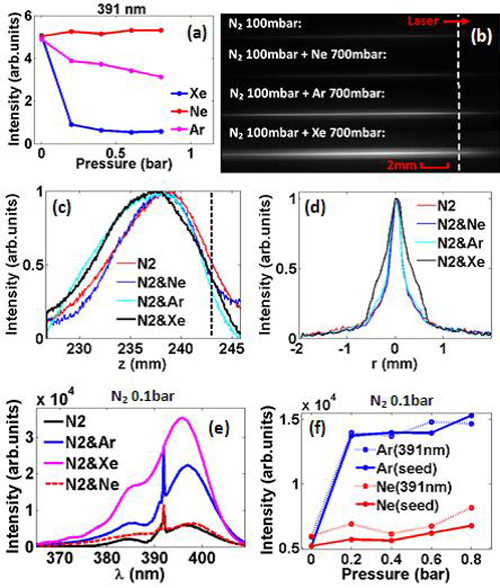The investigation of lasing from nitrogen molecules can date back to the early 1960s. Recent investigations have concentrated on molecular nitrogen laser initiated by amplified spontaneous emission (ASE) with the operation wavelength at ~337 nm or ~357 nm and atomic oxygen laser by ASE at 845 nm.
Recently, researchers from Prof. Ya Cheng and Prof. Xu Zhizhan’s group at Shanghai Institute of Optics and Fine Mechanics, Chinese Academy of Sciences(SIOM, CAS) reported a novel approach to realize switchable multi-wavelength laser in air and simultaneous multi-wavelength-generated ultraviolet laser in carbondioxide. And they studied the behaviors of the harmonic-seeded remote laser emissions at 391 nm wavelength from strong-field ionized nitrogen molecules in three different gas mixtures, i.e., N2-Ar, N2-Xe and N2-Ne. They observed a decrease in the remote laser intensity in the N2-Xe mixture because of the decreased clamped intensity in the filament; whereas in the N2-Ne mixture, the remote laser intensity slightly increases because of the increased clamped intensity within the filament. Remarkably, although the clamped intensity in the filament remains nearly unchanged in the N2-Ar mixture because of the similar ionization potentials of N2 and Ar, a significant enhancement of the lasing emission is realized in the N2-Ar mixture. The enhancement is attributed to the stronger third harmonic seed, and longer gain medium due to the extended filament. They also studied simultaneous laser emissions at 357 and 391 nm, or at 420 nm, 424 nm, and 428 nm by pump lasers with different wavelengths.
This work has been published on Optics Express, 20(19), 20970-20979, 2012.
This work is supported by the National Basic Research Program of China (Grant 2011CB808102), National Natural Science Foundation of China (Grant Nos. 11134010, 11074098, 60825406, 10974213), NCET- 09-0429 and the fundamental research funds of Jilin University.

Fig. (a) Experimentally measured fluorescence intensities at 391 nm in the three gas mixtures. The pressure of nitrogen is fixed at 0.1bar. (b) Images of femtosecond filaments in the three gas mixtures and pure nitrogen. (c) Normalized plasma luminescence intensity distribution inside the filaments in (b) along the direction of laser propagation. (d) Normalized plasma luminescence intensity inside the filaments in (b) in lateral direction. (e) Forward 3rd harmonic spectra in pure nitrogen (100mbar), N2-Xe gas mixture (100:200mbar), N2-Ar gas mixture (100:200mbar) and N2-Ne gas mixture (100:200mbar). (f) Comparison of the 391 nm lasing intensity and its seed intensity in N2-Ar gas mixture and N2-Ne gas mixture..